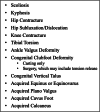Association between orthopedic manifestations and tethered cord release in patients with spina bifida: a survival analysis
- PMID: 40382509
- PMCID: PMC12085327
- DOI: 10.1007/s00381-025-06837-x
Association between orthopedic manifestations and tethered cord release in patients with spina bifida: a survival analysis
Abstract
Purpose: Patients with spina bifida (SB) are at risk for symptomatic tethered cord syndrome (TCS). Orthopedic decline, a common manifestation of TCS, is an indication for tethered cord release (TCR). Our objective is to determine if patients with SB who have undergone specific orthopedic operations (release of hip or knee contracture and correction of cavus foot) require TCR at a higher rate than those not undergoing these operations.
Methods: An institutional database was queried to identify all children with SB from 2009 to 2022. Data included functional level of lesion (FLOL), ambulatory status, and diagnosis of myelomeningocele (MMC) vs. closed neural tube defects. Survival analysis was performed to test the association between TCR and index orthopedic operations. Kaplan-Meier survival curves and multivariate Cox proportional hazard models were generated.
Results: There were 659 patients. Thirty-four (5.2%) had a history of orthopedic operation, and 625 (94.8%) had no history of orthopedic operation either before TCR or at last follow-up. Three of thirty-four (8.6%) in the orthopedic group underwent TCR after the orthopedic operation. Two hundred two of six hundred twenty-five (32.3%) in the non-orthopedic group underwent TCR. The adjusted hazard ratio (controlling for FLOL, ambulation, and diagnosis) was 3.8 (95% confidence interval 1.2-11). In MMC, the hazard ratio for the non-orthopedic group compared to the orthopedic group was 5.05 (95% confidence interval 1.2-20.7) which was significant.
Conclusion: Patients with MMC who underwent the specific orthopedic operations were significantly less likely to have subsequent TCR surgery. One possible explanation is that lower extremity deformity correction may alter surgeon behavior regarding TCR.
Keywords: Orthopedic; Spina bifida; Survival; Tethered cord.
© 2025. The Author(s).
Conflict of interest statement
Declarations. Ethical approval: All procedures performed in studies involving human participants were in accordance with the ethical standards of the institutional and/or national research committee and with the 1964 Helsinki Declaration and its later amendments or comparable ethical standards. This study was approved by the Institutional Review Board. Competing interests: The authors declare no competing interests.
Figures
Similar articles
-
First-time tethered cord release among adults with myelomeningocele: an analysis of people in the National Spina Bifida Patient Registry.J Neurosurg Spine. 2023 Jun 16;39(4):527-533. doi: 10.3171/2023.5.SPINE2328. Print 2023 Oct 1. J Neurosurg Spine. 2023. PMID: 37347622 Free PMC article.
-
Predictors of urinary continence following tethered cord release in children with occult spinal dysraphism.J Pediatr Urol. 2014 Aug;10(4):627-33. doi: 10.1016/j.jpurol.2014.06.008. Epub 2014 Jul 10. J Pediatr Urol. 2014. PMID: 25067798
-
Effect of early tethered cord release on urodynamic findings and lower urinary tract function in myelomeningocele patients.J Neurosurg Pediatr. 2024 Nov 1;35(2):137-143. doi: 10.3171/2024.8.PEDS24173. Print 2025 Feb 1. J Neurosurg Pediatr. 2024. PMID: 39486060
-
Fetal surgery for spina bifida.J Neurosurg Pediatr. 2019 Aug 1;24(2):105-114. doi: 10.3171/2019.4.PEDS18383. Epub 2019 Aug 1. J Neurosurg Pediatr. 2019. PMID: 31370010 Review.
-
What is the Role of Scoliosis Surgery in Adolescents and Adults with Myelomeningocele? A Systematic Review.Clin Orthop Relat Res. 2022 Apr 1;480(4):773-787. doi: 10.1097/CORR.0000000000002087. Clin Orthop Relat Res. 2022. PMID: 34939968 Free PMC article.
References
-
- Dias MS, Wang M, Rizk EB, Bowman R, Partington MD, Blount JP, Rocque BG, Hopson B, Ettinger D, Lee A, Walker WO (2021) Tethered spinal cord among individuals with myelomeningocele: an analysis of the National Spina Bifida Patient Registry. J Neurosurg: Pediatr 28(1):21–7. 10.3171/2020.12.PEDS20868 - PMC - PubMed
-
- Agarwalla PK, Dunn IF, Scott RM, Smith ER (2007) Tethered cord syndrome. Neurosurg Clin North Am 18(3):531–547. 10.1016/j.nec.2007.04.001 - PubMed
MeSH terms
LinkOut - more resources
Full Text Sources
Medical



